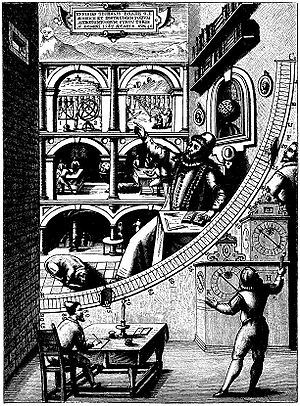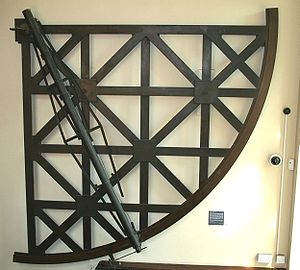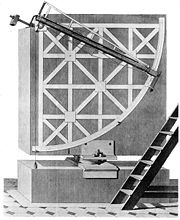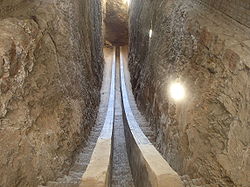
Mural instrument
Encyclopedia


Meridian (astronomy)
This article is about the astronomical concept. For other uses of the word, see Meridian.In the sky, a meridian is an imaginary great circle on the celestial sphere. It passes through the north point on the horizon, through the celestial pole, up to the zenith, through the south point on the...
. A mural instrument that measured angles from 0 to 90 degrees was called a mural quadrant.
Construction

The arc is marked with divisions, almost always in degree
Degree (angle)
A degree , usually denoted by ° , is a measurement of plane angle, representing 1⁄360 of a full rotation; one degree is equivalent to π/180 radians...
s and fractions of a degree. In the oldest instruments, an indicator is placed at the centre of the arc
Arc (geometry)
In geometry, an arc is a closed segment of a differentiable curve in the two-dimensional plane; for example, a circular arc is a segment of the circumference of a circle...
. An observer can move a device with a second indicator along the arc until the line of sight from the movable device's indicator through the indicator at the centre of the arc aligns with the astronomical object
Astronomical object
Astronomical objects or celestial objects are naturally occurring physical entities, associations or structures that current science has demonstrated to exist in the observable universe. The term astronomical object is sometimes used interchangeably with astronomical body...
. The angle is then read, yielding the elevation or altitude of the object. In smaller instruments, an alidade could be used. More modern mural instruments would use a telescope
Telescope
A telescope is an instrument that aids in the observation of remote objects by collecting electromagnetic radiation . The first known practical telescopes were invented in the Netherlands at the beginning of the 1600s , using glass lenses...
with a reticle eyepiece to observe the object.
Many mural quadrants were constructed, giving the observer the ability to measure a full 90° range of elevation
Elevation
The elevation of a geographic location is its height above a fixed reference point, most commonly a reference geoid, a mathematical model of the Earth's sea level as an equipotential gravitational surface ....
. There were also mural sextants
Sextant (astronomical)
Sextants for astronomical observations were used primarily for measuring the positions of stars. They are little used today, having been replaced over time by transit telescopes, astrometry techniques, and satellites such as Hipparcos....
that read 60°.
Usage
In order to measure the position of, for example, a star, the observer needs a sidereal clockSidereal time
Sidereal time is a time-keeping system astronomers use to keep track of the direction to point their telescopes to view a given star in the night sky...
in addition to the mural instrument. With the clock measuring time, a star of interest is observed with the instrument until it crosses an indicator showing that it is transit
Astronomical transit
The term transit or astronomical transit has three meanings in astronomy:* A transit is the astronomical event that occurs when one celestial body appears to move across the face of another celestial body, hiding a small part of it, as seen by an observer at some particular vantage point...
ing the meridian. At this instant, the time on the clock is recorded as well as the angular elevation of the star. This yields the position in the coordinates of the instrument. If the instrument's arc is not marked relative to the celestial equator, then the elevation is corrected for the difference, resulting in the star's declination
Declination
In astronomy, declination is one of the two coordinates of the equatorial coordinate system, the other being either right ascension or hour angle. Declination in astronomy is comparable to geographic latitude, but projected onto the celestial sphere. Declination is measured in degrees north and...
. If the sidereal clock is precisely synchronized with the stars, the time yields the right ascension
Right ascension
Right ascension is the astronomical term for one of the two coordinates of a point on the celestial sphere when using the equatorial coordinate system. The other coordinate is the declination.-Explanation:...
directly.
Famous mural instruments

- A mural sextantSextant (astronomical)Sextants for astronomical observations were used primarily for measuring the positions of stars. They are little used today, having been replaced over time by transit telescopes, astrometry techniques, and satellites such as Hipparcos....
was constructed in Ray, IranRay, IranRey or Ray , also known as Rhages and formerly as Arsacia, is the capital of Rey County, Tehran Province, Iran, and is the oldest existing city in the province....
, by Abu-Mahmud al-Khujandi in 994994Year 994 was a common year starting on Monday of the Julian calendar.- Europe :* Sweyn Forkbeard marries Sigrid the Haughty.* Otto III reaches his majority and begins to rule Germany in his own right....
. - Ulugh BegUlugh BegUlugh Bek was a Timurid ruler as well as an astronomer, mathematician and sultan. His commonly-known name is not truly a personal name, but rather a moniker, which can be loosely translated as "Great Ruler" or "Patriarch Ruler" and was the Turkic equivalent of Timur's Perso-Arabic title Amīr-e...
constructed the "Fakhri Sextant" that had a radius of 40 meters. Seen in the image on the right, the arc was finely constructed with a staircase on either side to provide access for the assistants who performed the measurements. - Tycho BraheTycho BraheTycho Brahe , born Tyge Ottesen Brahe, was a Danish nobleman known for his accurate and comprehensive astronomical and planetary observations...
's mural quadrant in UraniborgUraniborgUranienborg was a Danish astronomical observatory operated by Tycho Brahe; built circa 1576-1580 on Hven, an island in the Øresund between Zealand and Scania, which at that time was part of Denmark. The observatory was shortly after its construction expanded with an underground facility,...
at HvenHvenVen is a small Swedish island in the Öresund strait, between Scania and Zealand . It is situated in Landskrona Municipality, Skåne County. The island has 371 inhabitants and an area of . During the 1930s, the population was at its peak, with approximately 1,300 inhabitants...
. - The mural quadrant at the Greenwich Observatory.
- PtolemyPtolemyClaudius Ptolemy , was a Roman citizen of Egypt who wrote in Greek. He was a mathematician, astronomer, geographer, astrologer, and poet of a single epigram in the Greek Anthology. He lived in Egypt under Roman rule, and is believed to have been born in the town of Ptolemais Hermiou in the...
's mural quadrant at AlexandriaAlexandriaAlexandria is the second-largest city of Egypt, with a population of 4.1 million, extending about along the coast of the Mediterranean Sea in the north central part of the country; it is also the largest city lying directly on the Mediterranean coast. It is Egypt's largest seaport, serving...
. This instrument is also referred to as a plinth. - The obsolete constellation Quadrans MuralisQuadrans MuralisQuadrans Muralis was a constellation created by Jérôme Lalande in 1795. It was located between the constellations of Boötes and Draco, near the tail of Ursa Major...
represents a mural quadrant. - The mural quadrant at the Mannheimer Observatory. This is another of John BirdJohn Bird (astronomer)John Bird , the great mathematical instrument maker, was born at Bishop Auckland. He worked in London for Jeremiah Sisson, and by 1745 he had his own business in the Strand. Bird was commissioned to make a brass quadrant 8 feet across for the Royal Observatory at Greenwich, where it is still...
's instruments.

